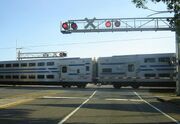
Top: An M7 railcar in Garden City. Bottom: An EMD DM30AC diesel locomotive pulling C3 railcars in Farmingdale.

Inside of an M7 railcar
The Long Island Rail Road owns an electric fleet of 836 M7 and 170 M3 electric multiple unit cars, and 134 C3 bilevel rail cars powered by 23 DE30AC diesel-electric locomotives and 22 DM30AC dual-mode locomotives. In 1997 and 1998, the LIRR received 134 double-decker passenger cars from Kawasaki, including 23 cab control cars,

LIRR bi-level coaches at grade level crossing in Bethpage, NY.
and 46 General Motors Electro-Motive Division diesel-electric locomotives (23 diesel DE30ACs and 23 dual-mode DM30ACs) to pull them, allowing trains from non-electric territory to access Penn Station for the first time in many years, due to the prohibition on diesel operation in the East River Tunnels leading to Penn Station. They were also the first trains with computerized voices (complete with LED sign displays) announcing stations along the routes. Starting in 1999, the LIRR bought 836 new electric M7 electric multiple units from Bombardier, replacing its M1 cars. These cars have an automatic station announcement and LED sign display system.
History[]
C3 Bi-level coaches at grade crossing in Bethpage.When the LIRR began operations in 1836, it leased the newly-opened Brooklyn and Jamaica Railroad, including its two duplicate steam locomotives, Ariel and Post Boy, both built by Matthias W. Baldwin. (Ariel was Baldwin's 19th engine, built in 1835.) The LIRR soon acquired, through the B&J, Hicksville in 1836 and John A. King (the only engine built by the Poughkeepsie Locomotive Company) in 1838. Post Boy was sold off after a 1852 accident.
Both the "Hicksville" and the "John A. King", were likely acquired second hand by the B & J in 1836 and 1838 respectively.
The "Hicksville" was acquired by the B & J in 1836 from a canal building concern "Proprietors Of Locks And Canals", based in Lowell Mass. This company is still in existence. According to Robert Stephenson Company records, in the year 1831, the firm of "Locks And Canals" purchased two locomotives new from the Robert Stephenson Company (order # 8 and 17) in England. It is likely the B & J purchased one of those two engines, second hand, from Locks And Canals in 1836, and renamed it the "Hicksville" (after Valentine Hicks, second President of the LIRR, and founder of Hicksville, NY). It is also likely, that at some point prior to its re- sale to the B & J, the engine in question was modified to Stephenson's famous 2-2-2 wheel arrangement.
According to "The History Of Brooklyn", by Hazelton, ca. 1920's, the LIRR acquired a second hand locomotive originally named the "Taglioni" from "the Dutchess County (NY) Railway, of British origin, with a large funnel smokestack". This is likely to be the "John A. King". The "Poughkeepsie Locomotive Works" may have only performed a wheel arrangement modification on a pre existing British built locomotive. It should be noted, that Poughkeepsie is also located in Dutchess County New York, hence the possible entity name confusion in the Hazelton book.
Long before modern piggyback services, the LIRR began carrying farm wagons aboard flatcars in 1885.
In the early 20th century, the LIRR was a testing ground for the Pennsylvania Railroad's electrification, including Phoebe, its first electric (AA1), and was the first company to extensively electrify its primary lines. The DD1 electric locomotives were developed from the prototypes that were tested on LIRR trackage. Later it saw power such as the B3.
The LIRR's steam passenger locomotives were modernized from 1901 to 1906, and by 1927, it was the first Class I railroad to replace all its wood passenger cars with steel.
In 1926, the LIRR was the first U.S. railroad to begin using diesel locomotives. The last steam locomotive was a G5s operated until 1955.
Electric storage battery cars were used on the West Hempstead Branch (Valley Stream to Mineola) from 1913 until it was electrified in 1926, and on the Bushwick Branch prior to the end of its passenger operations in 1924. The Central Branch from Garden City east to Mitchel Field was electrified with third rail in 1915, but used ex-Ocean Electric Railway trolley cars until 1933. Normal electric trains were then used until the line's abandonment in 1953.
One of the most popular decisions by Governor Rockefeller after the 1966 takeover was replacing the entire electric passenger fleet with M1 and M3 cars. It acquired 770 M1 cars built by Budd and General Electric from 1968 to 1974, and 174 M3 cars built by TransitAmerica in 1985 and 1986. Diesel-hauled trains through the late 1990s were operated using 1950s-era P72/PT75 series built by Pullman-Standard. About 28 EMD GP38-2 and MP15AC diesel-electric locomotives pulled about 223 passenger cars, mostly former electric multiple units.